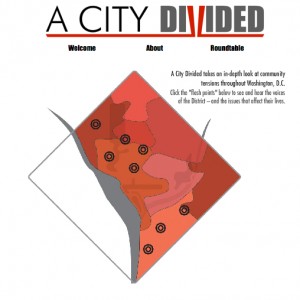Advancing the Conversation with “A City Divided”

http://www.acitydivided.americanobserver.net/
As promised, here is my interview with Jeremy Borden of “A City Divided“. Jeremy was the Managing Editor of this special edition of the American Observer, which examined many of the same issues DCentric does.
::
I asked him about the reaction ACD has received:
It’s been great as a whole. Even though people have their specific critiques, that shows they’re looking at the stories and reflecting on them. That is advancing the conversation in a way that is very positive.
What was the impetus behind the project?
What we tried to do was hone in on the broader trends that came out of the September primaries. We knew there was all this divisiveness that had been written about in a broad way; we wanted to focus on specific narratives that exposed divisions in the city and also illuminated the big issues of that election. That’s a difficult thing to do, but I think one of the things that has been most pleasing to me is that we did hone in on narratives that matter to people. Look at the conversations people are having, they are good conversations about the issues affecting this city.
What about the smattering of negative reactions you’ve received online?
As journalists we do the best that we can within the constructs set out for us. What I think is extremely unfair– and there was only one comment like this, that felt we were being racist in our coverage…I felt the need to respond to that. Not everyone will have the same point of view, but all in all it’s been a really positive thing.
How do you respond to criticism that the multimedia map you offer is inaccurate? DCist said:
“There were some places that I do feel the writers missed the mark: for starters their front image, a map of D.C. with the ward lines has markers where their stories take place, and they are just inaccurate geographically. Columbia Heights is in Ward 1, yet a lot of the Columbia Heights stories are situated in Ward 2, according to their map. And then there’s the fact that, according to their map U Street lies north of Columbia Heights.”
The problem we were facing was we didn’t want to place all the dots (representing “flashpoints”) together, we wanted people to be able to differentiate between what they were clicking. We should’ve been more clear that it was representative of a general area and not precise. If you have a bunch of dots stacked on top of each other, would people be able to access the stories there? In hindsight, we should’ve been more transparent about that and we might have formatted the map differently, so the wards weren’t as defined because people do have the right to make that point, they are correct, the lines are not exactly where they should be if the map was 100 percent geographically accurate. I think that’s fair criticism.
What about the fact that the story, “Priced out in Columbia Heights” features interviews…with people from Mt. Pleasant. I live in Columbia Heights and the two neighborhoods are distinct.
We were trying to write for a city-wide audience and people who have an interest in these issues who are not from here. The interviews reveal experiences with that area in general. We went back and forth about this, but most people who don’t live there…when they refer to that area of the city, the call it Columbia Heights. I can understand some of the confusion, especially because that story got the most reactions. This is something that is happening not only in Columbia Heights, but other areas too, so that really hit a nerve.
And the stories that haven’t received as many reactions? Tell me about some of those.
We had a story about barbershops in ward 3 and ward 8 which is really interesting. It’s interactive, has great photos and is a strong story. That was our “above the fold” story. We also did a series of stories on ward 8. They didn’t get as much attention in the blogoshpere, but from what we can tell from the stats, people did click around and read us, which is great. There’s also an interesting story talking about the changing U street community.
What would you do differently?
When I originally conceived this, I wanted to make sure we had one story from each ward because these issues do exist in one way or another in each ward. That was one of the goals, but we didn’t necessarily get to do that. This was created by volunteers. Only people who were interested in this type of reporting did it. We did want to spread ourselves as wide as we geographically could, because there were other stories in other parts of the city, but we didn’t have the resources to cover them.
Who else was part of it?
A good team of us pulled together to get this done, from people who wrote to Jeremiah Patterson who did a lot of multimedia and Matt Boyle, who did design work. Dan Merica helped too, beyond his role as a reporter. Kate Musselwhite did social media and outreach as well as stories about Anacostia. I’m probably forgetting someone…
Hey, it happens.
We were a small team but we were able to pull this together, which wasn’t easy.
And going forward?
There has been some interest in trying to continue it, but we’re unsure of whether we’ll do that. We can’t do it on a daily basis, but we’d like to continue to report on these issues. The narrative will continue for as far as we can see. It would be interested to see how our coverage would morph as these issues change.
::
Be sure to tune in tomorrow, when I speak to Dan Merica about his piece (which Jeremy referred to, above), “Different worlds reflected in the barber’s mirror“.






